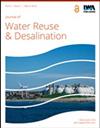Degradation of sulfonamide antibiotics in the rhizosphere of two dominant plants in Huixian karst wetland, Guangxi, China
IF 2.3
Q2 Environmental Science
引用次数: 1
Abstract
In this work, Phragmites australis and Vallisneria natans were selected as the research objects and were cultured for 10 d under 0.10 μg L−1 sulfadiazine (SD) stress in a simulated surface flow wetland reactor. SD degradation was conducted at pH = 7 and 25 °C for 96 h. Each plant group conformed to the first-order kinetic model of degradation, and the degradation rate increased with time, reaching the maximum at 96 h. At 96 h, the degradation rate of P. australis communities was higher than that of V. natans. SD metabolites showed that the degradation pathways in the plant rhizosphere were mainly hydroxylation, aminolation, and S–N bond cleavage. In the analysis of rhizosphere bacterial community structure, the bacterial phyla that could degrade antibiotics accounted for a large proportion. Compared with before degradation, the dominant phylum and genus did not change after degradation (96 h), but their abundance changed to varying degrees, and new genera appeared in the P. australis group. This research provides a reference for the degradation of antibiotics in karst areas and new information on the mechanism of SA degradation in the plant rhizosphere.广西惠县喀斯特湿地两种优势植物根际磺胺类抗生素的降解
本研究以芦苇(Phragmites australis)和水草(Vallisneria natans)为研究对象,在模拟地表流湿地反应器中,在0.10 μg L−1磺胺嘧啶(SD)胁迫下培养10 d。在pH = 7和25°C条件下,SD降解96 h,各植物类群均符合一级降解动力学模型,降解速率随时间增加而增加,在96 h时达到最大值,96 h时南方稻属群落的降解速率高于水杨属群落。SD代谢产物表明,SD在植物根际的降解途径主要为羟基化、氨基化和S-N键裂解。在根际细菌群落结构分析中,能降解抗生素的细菌门占很大比例。与降解前相比,降解后(96 h)优势门和优势属没有发生变化,但丰度发生了不同程度的变化,在南方杨类群中出现了新的属。本研究为喀斯特地区抗生素的降解提供了参考,也为植物根际SA降解机制的研究提供了新信息。
本文章由计算机程序翻译,如有差异,请以英文原文为准。
求助全文
约1分钟内获得全文
求助全文
来源期刊

Journal of Water Reuse and Desalination
ENGINEERING, ENVIRONMENTAL-WATER RESOURCES
CiteScore
4.30
自引率
0.00%
发文量
23
审稿时长
16 weeks
期刊介绍:
Journal of Water Reuse and Desalination publishes refereed review articles, theoretical and experimental research papers, new findings and issues of unplanned and planned reuse. The journal welcomes contributions from developing and developed countries.
 求助内容:
求助内容: 应助结果提醒方式:
应助结果提醒方式:


